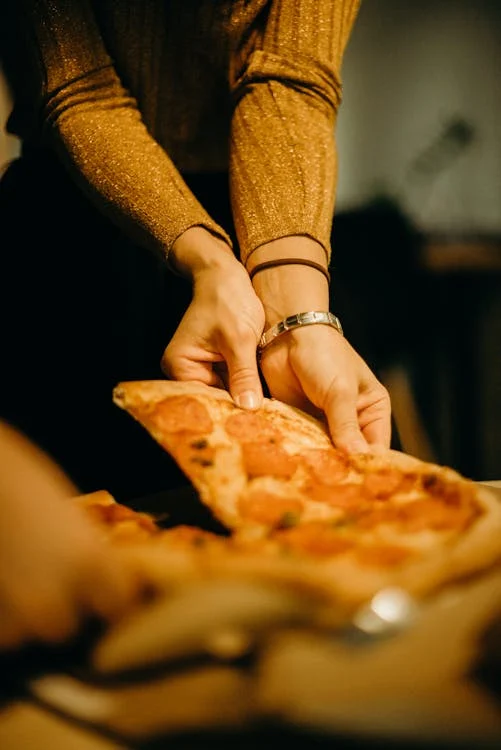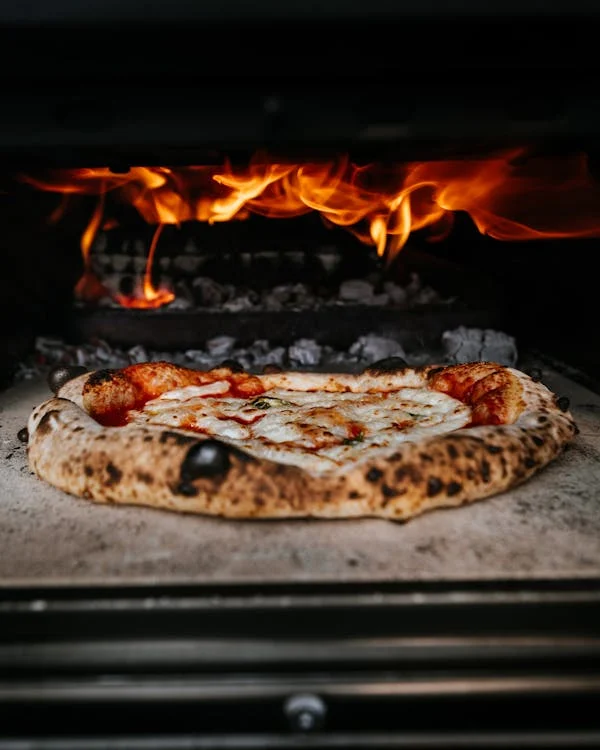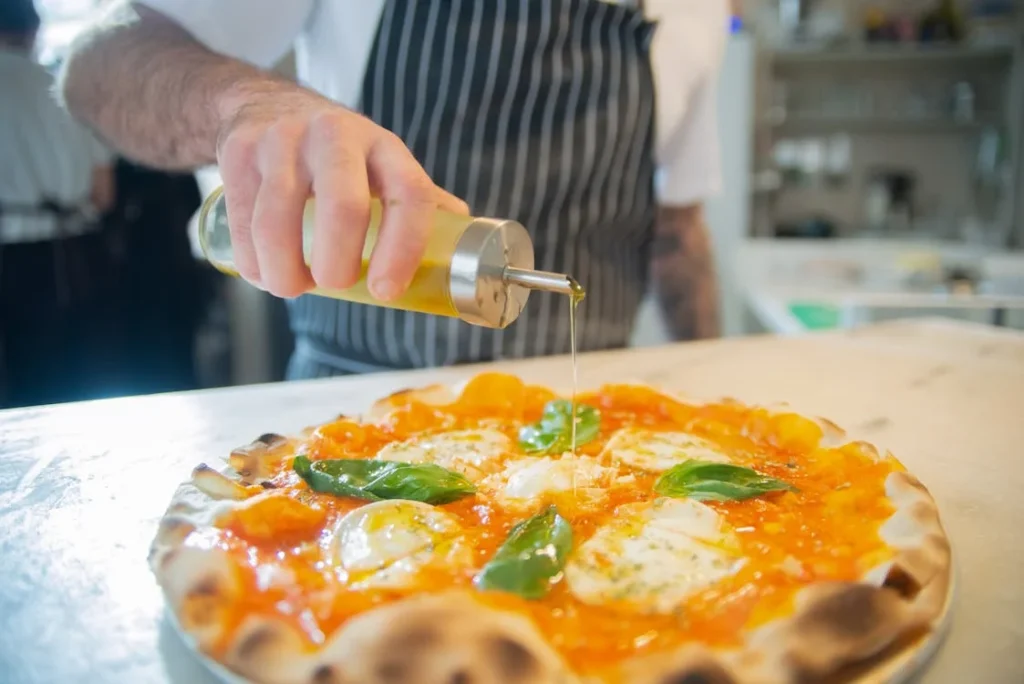Ask any food lover, and they will say it—the best pizza starts not with the toppings, but the crust. The mysterious crispy pizza crust is a culinary miracle that depends not just on high-quality pizza dough ingredients but also on exact baking methods, advanced processes, and artisan-level craftsmanship. In the world of pizza crust, where each subtlety from hydration to heat transfer can affect texture, control over the basics becomes paramount.
From choosing the proper pizza crust recipe to baking your pizza at the proper temperature and for the proper duration, the path to creating the perfect crunch is a sensory journey. When executed correctly, pizza crusts become more than a culinary purpose, they are architectural artistry. What’s the secret to the perfect crispy pizza crust? Let’s find out!

Flour Fundamentals and Dough Science
The genesis of a sublime pizza crust lies in the type of flour selected. Bread flour with high protein content gives a strong structural matrix, allowing higher gluten development, which has a direct relationship with chewiness and crispness.
Italian flour, with its fine grind, gives a crispy bite. Things like how much water you use, how long you let the dough rest, and even how it matures—all these factors play a big role in what you end up with in the end. It’s a bit of a dance among all these pieces to produce the ideal bite.
Key points to consider:
- Levels of Hydration: A hydration amount of 65–70% gives rise to a porous interior with space for a crusty, crackly outside.
- Enzymatic Activities: Fermentation at low temperatures (24–48 hours) helps enzymes to develop gluten and complex taste.
- Essential Additions: Including olive oil, sea salt, and a touch of sugar helps enhance taste and browning during the bake.
Thermal Dynamics: Baking Surfaces, Temperature Control
Thermal efficiency is the essential factor in obtaining a crusty pizza crust. Using steel plates or ceramic rocks that imitate fiery high-heat conditions, commercial pizzerias attempt to recreate hearth-style cuisine. Cooking the pizza directly on a warm surface that focuses evenly on heat, like The Original Baking Steel, ensures quick bottom heat transfer, leading to instant oven spring and a caramelised & blistered crust.

Mastering the Temperature:
- Ideal heat range: Residential ovens (475°F–500°F); commercial ovens (700°F–900°F).
- Preheating Time: Minimum preheating time ensures uniform crust texture and thermal saturation.
- Optimization of Time: For ideal crust color and crunch, regular baking time is 6–8 minutes.
Want to master the thermal dynamics of baking? Check out this article, which discusses the thermal profiling for baking.
Controlling Dough Fermentation and Proofing
Crust excellence rests on the two support systems of proofing and fermentation. Best carried out over a long time at low temperatures, the fermentation process enables yeast and enzymatic activity to introduce sophisticated flavours as well as improve chew and elasticity.
Running from 24 to 72 hours during extended cold fermentation gives improved moisture retention and a more robust gluten network without a reduction in the crispy pizza crust exterior. This improves the structural resistance of the dough, allowing for a better oven spring and texture.
Want some solid precision proofing tips? Here you go!
- Monitor Rise: Dough will double visibly in bulk without sagging.
- Tactile Response: Well-proofed dough will gradually rebound when pressed.
- Proofing Pitfalls to Avoid: Over-proofed dough will shrink under intense heat, whereas under-proofed dough produces a dense, tough crust.
Remember, before it bakes, it breathes.
Moisture Management: From Sauce to Toppings
A fundamental but frequently overlooked determinant of pizza crust success is moisture management. Even the best-pampered dough can fail against too much topping moisture, resulting in a soggy, limp foundation that has no structural integrity.
Toppings such as mushrooms, onions, tomatoes, and spinach have high water content naturally. When they undergo oven heat, they release moisture that migrates into the crust and ruins its much-needed crunch.
Moisture Control Protocol
Proper moisture management isn’t just a recommendation—it’s a non-negotiable standard in elite pizza-making. Moisture can sabotage even the most well-crafted pizza crust, turning a gorgeous blistered base into a disappointing soggy mess. As such, each layer, from sauce to topping, needs to be addressed with calculated restraint and gastronomic prescience.
Here’s how you can do it seamlessly :
- Pre-cook or dehydrate toppings with high moisture content to minimize internal water content.
- Employ reduced-sodium and thick sauces that will not leach water into the crust.
- Place cheese below the sauce layer to generate an insulation barrier that will preclude seepage of the sauce.
Par-Baking: A Structural Masterstroke
Par-baking, a frequently underappreciated yet strategically revolutionary technique, is an invaluable tool in the quest for a better pizza crust. Par-baking or partial baking, in essence, is the initial cooking of the dough before any topping.
This first phase creates a semi-set, hard foundation, which is a block for structure, preventing the topping-caused moisture from harming the crust and allowing it to preserve its crunchy texture, essential for a refined gastronomic experience. The process not only strengthens the crust but also assures a more uniform bake, particularly where high-moisture foods or heavier toppings are involved. Also, par-baking works best in commercial businesses or advanced meal preparations, where pizzas are pre-built and then finished in a second bake cycle without compromising the quality of the crust.
When executed properly—usually by preheating the oven and baking surface to 475°F–500°F and baking the formed dough for about 4–6 minutes—par-baking gives the crust a pale golden color and a base crunch that still holds up after a complete bake with toppings.
Best Practices for Par-Baking:
- First off, get that oven fired up—aim for a toasty range of about 475°F to 500°F. Seriously, it’s a game changer.
- Once your dough is all rolled out and ready to go, slide it into the oven for roughly 4 to 6 minutes. But, hey, don’t just walk away! Keep an eye on it, alright? You’re looking for the edges to take on a nice golden hue—not burnt, not at all! Just golden.
- After that, let it cool down a bit before you throw on your toppings. And then, well, finish it off with that final bake. Easy peasy, right? Happy baking
Read our blog on how great pizza starts long before the first bite.
Flavor Enhancement Through Oil and Finishing Techniques
A great crispy pizza crust does more than crackle—it invites aromatic depth and layered richness. Finishing techniques, especially the careful application of infused oils and compound butters, take crust from structural foundation to gourmet canvas.

Brushing with olive oil pre-bake promotes a golden color and blistered crust, while truffle oil or garlic herb butter post-bake finishes provide a sensory climax. Dusting with cornmeal or semolina on the peel at strategic points also avoids sticking and contributes to surface crunch.
Manny & Olga’s: A Testimony to Crust Excellence
With our reputation for offering hand-stretched dough and expertly perfected baking methods, Manny & Olga’s best captures what high-quality pizza crust must be all about—crunch, harmony, and unmatchable consistency.
Explore a universe of crust ingenuity and order your gourmet slice today.
